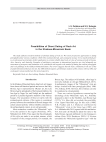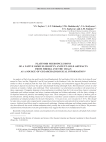Archaeology, Ethnology & Anthropology of Eurasia @journal-aeae-en
Статьи журнала - Archaeology, Ethnology & Anthropology of Eurasia
Все статьи: 524

Peculiarities of using 2D electrical resistivity tomography in caves
Статья
The effi cienc y of archaeological studies inside caves could be greatly enhanced by geophysical methods because of their potential for examining deposit structure and features. Application of those methods in caves entails a number of problems caused by limited space for measurements and the complexity of the surrounding medium’s structure as compared to above-ground measurements. In 2017, Selungur Cave in the Fergana Valley, Kyrgyzstan, was examined using electrical resistivity tomography. Because of the above concerns, in the course of the work the question of the reliability of the results arose. To clarify the issue, a numerical experiment was performed to assess the effect of the three-dimensional cave geometry on the results of a two-dimensional inversion. It was found that variations of cave geometry parameters result in unexpected false anomalies, and considerable errors in bedrock location and resistivity can occur. In the case of downward diverging cave walls, an accurate resistivity section can be obtained by using the inversion based on a two-dimensional model. Therefore, electrical resistivity tomography in caves with similar geometry can yield reliable resu lts concerning the shape of bedrock surface, the thickness of sedimentary layers, and size and position of inclusions such as fallen fragments of roof therein.
Бесплатно

Percussive-abrasive stone tools from Chagyrskaya cave: results of functional analysis
Статья научная
This article presents a comprehensive study of percussive-abrasive active stone tools from Chagyrskaya Cave, using experimental use-wear and statistical methods, supplemented by 3D-modeling. Experiments combined with use- wear analysis allowed us to determine the functions of these tools by comparing the working surfaces and use-wear traces in the Chagyrskaya samples with those in the reference samples. As a result, we identified 19 retouchers, four hammerstones for processing mineral raw materials, and one hammer for splitting bone, which indicates the dominance of secondary processing over primary knapping in the Chagyrskaya lithic assemblage. Using statistical analysis, we traced the differences in the dimensions of the manuports and lithics under study. These artifacts are a promising and underestimated source of information for identifying working operations associated with stone- and bone-processing; moreover, they can provide new data on the functional attribution of sites and the mobility of early hominins.
Бесплатно

Philip Johan Tabbert von Strahlenberg: an 18th century Swedish prisoner’s research in Siberia
Статья научная
This article analyzes the work done by the Swedish prisoner of the Great Northern War Philip Johan Tabbert von Strahlenberg during his stay in Siberia and aimed at exploring ancient and traditional cultures of Western Siberia and the Minusinsk Basin. A brief overview of earlier studies is presented. The conditions of Strahlenberg’s work are outlined. His main interests, from his arrival in Siberia’s capital until his return to Sweden, concerned the cartography, ethnology, and archaeology of the environs of Tobolsk and of the entire Western Siberia, Minusinsk Basin, and Southern Siberian highlands in particular. Some episodes in Strahlenberg’s activities as a researcher and collector are described with a focus on the difficulties he experienced, specifically when collecting ancient artifacts and written documents. Certain results of his research are highlighted. From the modern standpoint, the article examines the significance of Strahlenberg’s work for Russian archaeology at the stage when its basis of sources was being formed. His place among the first experts in Western and Southern Siberian ancient and traditional cultures is assessed. The key role in the organization and consolidation of research in the remote fringes of the Russian State in the early 1700s belonged to the Russian Academy of Sciences.
Бесплатно

Pit-grave (Yamnaya) and pit-grave-maikop burials at Levoyegorlyksky-3, Stavropol
Статья обзорная
Бесплатно

Статья научная
This study reconstructs biological affinities in a cranial sample from a collective burial on Cape Bratyev in Babushkin Bay. The burial, found in a rock niche on the Okhotsk Coast, was excavated by S.P. Efimov in 1976 and tentatively attributed to the Old Koryak culture. The sample consists of 13 adult skulls of differing preservation—five male, five female, and three undeterminable. Genome-wide analysis was carried out at the Center for Geogenetics of the University of Copenhagen. Paleogenetic data support the archaeological hypothesis attributing the burial to the Old Koryak culture. The results of the craniometric analysis suggest that the Old Koryak population was heterogeneous. Cranial data indicate population contacts between ancient Koryaks and the Epi-Jōmon people of Hokkaido. Also, they reveal common episodes in the population history of the group from Cape Bratyev and the Okhotsk culture people. Two of the three Okhotsk samples used for comparative analysis demonstrate very close affinities with individuals studied. According to the previous studies and our current analysis, the Okhotsk people resulted from the admixture of ancient groups related to Chukchi and Eskimo, on the one hand, and Tungus-Manchu groups, on the other. A significant difference between the Old Koryak population and that of Okhotsk culture is that the former includes a component related to Nivkhs.
Бесплатно

Статья научная
Porotic hyperostosis (PH) is the skeletal marker used in the estimation of physiological stress suffered in childhood. Despite a conventional hypothesis that mankind’s health conditions declined with the advent of agriculture, there are few reports comparing the PH seen on ancient crania of hunters-fishermen-gatherers and agrarian peoples. In this study, we examined the crania of 16th to 19th century Eurasian peoples: Siberian natives (hunters-fishermen-gatherers), Russian settlers, and Joseon Koreans (agriculturalists) to see whether PH could be observed to differ between populations with varying subsistence strategies. The prevalence of PH decreased in the order of Joseon people (18.9 %), Russian settlers (6.3 %), and Siberian natives (3.8 %). In brief, the hunters-fishermen-gatherers’ stress level was lower than agriculture-based Joseon people and Russian settlers. In addition, Joseon people might have been exposed to more serious stressful episodes than Russian settlers were. We assume that the former might have lived under much stressful conditions than the latter did, though both people depended on intense agriculture. As for sexual dimorphism of PH: in all groups, males were identified with more PH signs than females were. Our report successfully shows that the detailed pattern of stress markers might have been influenced by complex interactions between various factors that existed under different conditions in history.
Бесплатно

Possibilities of direct dating of rock art in the Khakass-Minusinsk basin
Статья научная
The study addresses modern methods of absolute dating of rock art. We review prospective approaches to dating petroglyphs under various conditions: AMS, OSL, uranium-thorium, and cosmogenic isotope. Not so much methods per se are discussed as principles of their application to certain reliably dated rock art sites of various periods in Europe, Asia, America, and Australia. Examples of satisfactory outcomes in international practice are cited alongside our assessment of prospects and limitations to be considered with regard to the method of dating the earliest petroglyphs and rock paintings in the Khakass-Minusinsk Basin. The review suggests that the basic conditions for the use of the uranium-thorium method are not met, the AMS method requires a preliminary analysis of the context, whereas OSL and cosmogenic isotope method are the most prospective.
Бесплатно

Статья научная
This article outlines the findings of a technological study of the Kulai ceramics from Barsov Gorodok III/6 near Barsova Gora, on the right bank of the Ob River, Tyumen Region, Khanty-Mansi Autonomous Okrug. We describe the site, its stratigraphic sequence and planigraphy, and the layout of the dwellings. The analysis was performed using binocular microscopy of traces in fresh transverse and longitudinal fractures of potsherds. Results were compared with those relating to the experimental sample. The examination of 50 specimens revealed a conservative tradition typical of the potters’ substrate skills. Its characteristics included the use of homogeneous clay mined near reservoirs in one and the same area, and the technology was based on bottom-to-body or body-to-bottom coiling. The body was constructed by side coiling. Adaptive skills were variable. Four mixed recipes for clay paste are described, making up one-fifth of the total number of recipes: clay + broken stone + chamotte; clay + broken stone + liquid organics; clay + + chamotte + sand; clay + broken stone + sand; and two unmixed recipes: clay + broken stone; and clay + chamotte. The mechanical processing of surface is variable, being based on 16 techniques and their combinations. Techniques used at various stages of pottery manufacture are listed. Simple paste recipes indicate groups of potters representing various traditions. Mixed recipes attest to a blend of traditions. Those using them might have been monocultural or multicultural groups of potters using different techniques and skills.
Бесплатно

Статья научная
This article presents the findings of a multidisciplinary analysis of pottery belonging to the Novosibirsk variant of the Kulaika culture. Technological (traceological), petrographic, X-ray phase, and thermal analyses were carried out, providing a basis for an objective reconstruction of the pottery technology. Raw material used at two sites, Kamenny Mys and Dubrovinsky Borok-3, originated from a single region, but from different mines. Three types of clay were used at the former site, and two at the latter, evidencing several groups of potters using various types of clay. Correlation between the types of clay and composition of the paste supports this idea. The clays used at Kamenny Mys are quite different from those used at Dubrovinsky Borok-3 in terms of mineral composition, as shown by petrographic and X-ray phase analyses. According to the thermo-gravimetric analysis, the samples fall into groups differing in the quality of firing. Certain vessels were subjected to more intense firing than others.
Бесплатно

Prevalence of caries among Siberian Tatars of the Omsk region in the 17th to early 20th centuries
Статья обзорная
Бесплатно

Статья научная
We outline the result of collaboration by a team of more than sixty researchers from 22 Russian and 13 foreign institutions under the project implemented by the Research and Educational Center for Altaic and Turkic Studies “Greater Altai” in 2022–2023. Six archaeological and four ethnographic expeditions were carried out in the Russian Federation, the Republic of Kazakhstan, and the Kyrgyz Republic. Findings concern the origin of the Turkic ethno-cultural complex and its spread across Central Asia. Archaeological surveys revealed new sites, many of which were excavated, and some were included in the museum projects. Extensive photographic and volumetric documentation was conducted. In the course of ethnographic expeditions, Turkic epic texts were collected, many elements of traditional culture were revealed, showing parallels between Altaic and Kyrgyzian traditions. Also ethnographic parallels were documented between Slavic and Turkic cultures of the Greater Altai. These were used to elaborate the concept of Slavo-Turkic unity, which has both theoretical and practical implications.
Бесплатно










